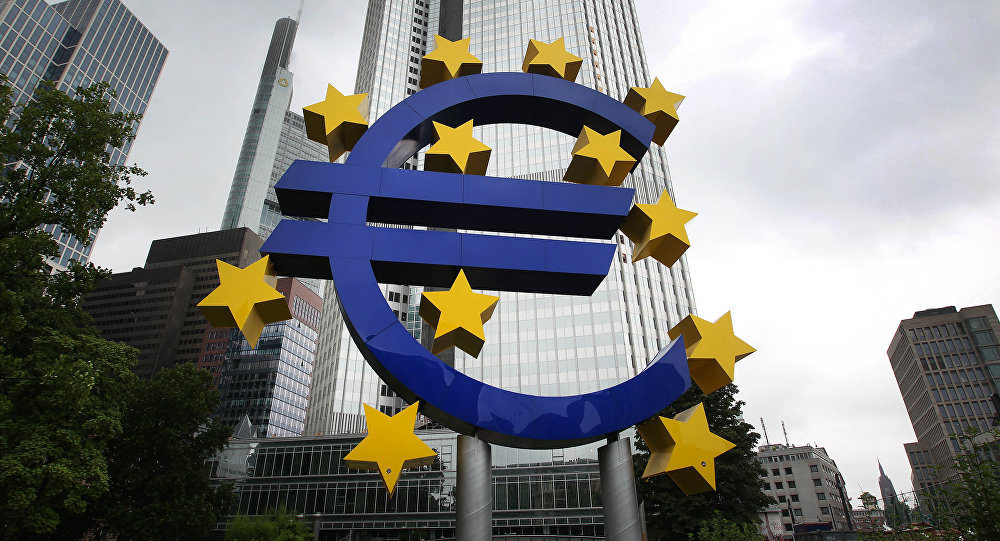Kristian Rouz - Mario Draghi, President of the European Central Bank (ECB), said the unconventional monetary policies are still necessary to support the pace of economic expansion in the Eurozone, as the regulator awaits new evidence of macroeconomic stability.
The gradual removal of the negative interest rate policy (NIRP) on bank deposits and zero base interest rates, along with ECB asset purchases, would require a higher inflation and a more balanced growth across the 19-nation bloc.
Comment: The ECB can't pull back on the stimulus: Will the crazy global debt bubble ever end? It can't or else
Ahead of the 8 June ECB policy meeting, President Draghi cited the still moderate inflation as the main reason to keep stimulus policies in place. Even though the German economy has driven the Eurozone's economic expansion to its best in roughly a decade, growth discrepancies across the monetary union still pose significant structural challenges to the Eurozone.
"For domestic price pressures to strengthen, we still need very accommodative financing conditions, which are themselves dependent on a fairly substantial amount of monetary accommodation," Draghi said in a speech before the European Parliament's committee on economic affairs.
Germany, along with other Northern European member states, favors a sooner normalization in the ECB's monetary policies, as the labor market improvements and gains in inflation suggest the extended period of loose monetary conditions could produce a dangerous overheating in the economy. Robust exports and domestic investment, as well as consumer activity, allow for a more expensive credit in Northern Europe, which would also help stave off the risk of credit bubbles forming.
In Southern Europe, however, a loose monetary environment is still vital to support positive GDP growth amongst the member states. This reflects the long-lasting structural problems of the Eurozone, where the regional discrepancies in economic expansion pose an existential threat to the common currency area, and the ECB's mandate is to find balanced monetary solutions allowing the Eurozone to move forward.
"At its June monetary policy meeting the Governing Council will receive an update of the staff projections and a more complete information set on which it will be able to formulate its judgment on the distribution of risks around the most likely outlook for growth and inflation," Draghi said.
Eurozone consumer prices and core inflation both slowed recently, to 1.4 and 1.0 percent, respectively, after accelerating to almost 2.0 and 1.4 percent earlier this year. Draghi and the ECB staff are considering exit strategies from the asset purchase and zero-to-negative rate policies, but the timeline is still undecided, as there is little predictability in overall Eurozone growth and inflation. Whilst there is more certainty with the German economy, the lingering banking sector woes in Italy and low economic efficiency in France bring a significant degree of volatility in the ECB planning.
"Draghi will explain that the improvement in the economy is not sufficient at this point to make sure that the improvement in the inflation outlook is self-sustained," Philippe Gudin of the British bank, Barclays Plc., said. "We are still far from the point at which we could see inflationary pressures materializing."
The size of the ECB's bond-buying program has reached some $2.6 trillion, and the ongoing central bank buyouts of private debt provide support to domestic investment in the Eurozone in the absence of single fiscal policy within the bloc. Even though the Eurozone's unemployment rate has dropped to the current 9.5 percent from 12 percent in 2013 (3.9 percent from 5.3 percent in Germany and 9.6 from 10.4, in France), and euro-area economic activity and confidence near six-year highest, the structural imbalances are preventing the ECB from normalizing their monetary policy.
Eurozone inflation, however, is poised to remain subdued even in the longer-term outlook. According to Bloomberg estimates, euro-area inflation will only accelerate to 1.8 percent in 2021, whilst the European Commission is expecting 1.3-percent inflation in 2018.
The ECB recently reaffirmed their commitment to start raising interest rates only after the asset-purchase program is wrapped up, but the current purchases of 60 billion euro worth of bonds per month are projected to continue till the year-end. This is making any substantial changes to the ECB policies a more distant perspective, adding risks to the German economy, where the Bundesbank might take action aimed at stabilizing the buoyant growth.
In September, the ECB will determine whether to extend its bond purchase program into the next year.




Reader Comments